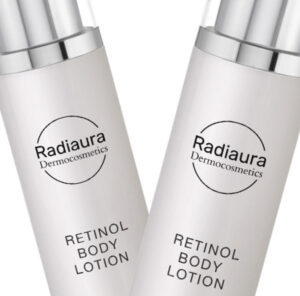January 20, 2025
Retinol’s Impact on the Skin Microbiome and Chronic Radiation Dermatitis

The Complex Skin Ecosystem: A Delicate Balance
The skin is home to a complex ecosystem called the microbiome, which plays a crucial role in overall skin health. This delicate balance can be disrupted by various factors, including chronic radiation dermatitis (CRD). CRD is a long-lasting skin reaction that arises after the acute symptoms of radiation dermatitis have healed. It includes changes like thinning of the outer skin layer, loss of dermal tissue, blood vessel damage, scarring, and thickening of the skin1. These changes can cause various issues, such as dry skin (xerosis), altered pigmentation, inflammation, fibrosis, altered pH, compromised skin barrier function, increased transepidermal water loss (TEWL), and changes in the skin microbiome1-6.
Although the skin may initially look normal, it can later show persistent changes that can greatly affect the quality of life for those impacted4. Understanding the mechanisms underlying these manifestations is crucial for effective management strategies. Topical retinol, a potent derivative of vitamin A, has garnered attention for its multifaceted effects on skin health. The application of retinol has been shown to induce significant changes in the skin’s structure and microbiome composition, which may have implications for conditions such as CRD.
The skin is covered with billions of bacteria, fungi, and viruses. This microbiome helps protect against harmful pathogens, regulates inflammation, and maintains skin barrier function. A healthy microbiome consists of commensal species protecting against pathogenic bacterial species to promote a balance environment for skin cells. Radiation dermatitis can affect the microbiome and result in decreased bacterial diversity6. The delayed recovery of radiation dermatitis has been shown to be associated with a raised Proteobacteria/Firmicutes ratio as well as overrepresentation of Pseudomonas, Staphylococcus, and Stenotrophomonas.6 Imbalance in the microbiome with overgrowth of harmful bacteria can compromise the skin barrier, leading to further complication such as infections and prolonged dermatitis6, 7. Radiation can disrupt the normal pH balance of the skin, often with an alkaline shift, contributing to microbial imbalance and susceptibility to infections and further inflammation5. Restoring microbial balance may be beneficial for patients suffering from CRD.
“Radiation therapy is a common cancer treatment method that can lead to various side effects, one of which is chronic radiation dermatitis. Chronic radiation dermatitis is a long-lasting skin reaction that arises after the acute symptoms of radiation dermatitis have healed.”
Retinol’s Potential for Microbiome Modulation
Retinol, a derivative of vitamin A, is known for its skin benefits. It helps reduce acne, improve wrinkles, and enhance overall skin appearance. Recently, researchers have started exploring its influence on the skin microbiome, revealing promising results that may help address conditions like CRD.
Research indicates that retinol can alter the skin microbiome by promoting the growth of beneficial microbial species while inhibiting pathogenic ones. This is thought to be achieved through the secretion of acidic metabolites, such as phenylglyoxylic acid, which lower the skin pH and enhance the skin’s barrier function8. Retinol may alter the diversity of skin bacteria, for example, reducing the colonization of pathogenic bacteria such as Stenotrophomonas maltophilia, Acinetobacter johnsonii, Pseudomonas sp., and Sphingomonas hankookensis8. Retinol also enhances the expression of antimicrobial peptides, which are vital for defending against skin infections9.
Retinol's Influence on Skin Barrier Repair
A strong skin barrier prevents moisture loss and protects against irritants. For those with radiation dermatitis, maintaining this barrier is vital for recovery. The initial acute response to radiation includes erythema and desquamation, which can evolve into chronic conditions characterized by xerosis. This occurs due to impairment of basal stem cells and senescence of epidermal keratinocytes which are essential for maintaining skin hydration and barrier integrity10. This compromised barrier further exacerbates dryness and can lead to a cycle of irritation and inflammation10, 11.
TEWL is a critical factor in the development of xerosis and compromised barrier function. Radiation-induced damage to the stratum corneum can lead to increased TEWL, resulting in dry, flaky skin12. The loss of water from the epidermis not only contributes to dryness, but also impairs the skin’s ability to heal and regenerate, perpetuating the cycle of dermatitis.
Radiation can cause vascular injury, leading to changes in blood flow and nutrient delivery to the skin. This can result in hypoxia and further exacerbation of skin damage, contributing to the chronic nature of the dermatitis4.
Retinol: Promoting Barrier Function
In addition to its effects on the microbiome, retinol is known to stimulate collagen synthesis and enhance the extracellular matrix production in the skin13. This is crucial for maintaining skin integrity and promote healing. Studies have shown that retinol increases the activity of fibroblasts, leading to enhanced collagen production and improved skin elasticity13, 14. The thickening of the epidermis and increased collagen density may help mitigate the effects of CRD, which often includes skin atrophy and loss of elasticity. Additionally, retinol’s role in reducing TEWL15, 16 can help maintain hydration, which is often compromised in radiation-damaged skin.
Retinol and Inflammatory Reponses
Inflammation is a common response to radiation damage. It contributes to redness, swelling, and pain. Management of this inflammation is crucial for healing and comfort. CRD is marked by ongoing inflammation, which can lead to fibrosis11. The initial inflammatory response to radiation is characterized by the infiltration of immune cells, including lymphocytes and macrophages, which release pro-inflammatory cytokines17. Over time, this chronic inflammation can stimulate fibroblast activity, resulting in excessive collagen deposition and fibrosis, which manifests as thickened, sclerotic skin4. This fibrotic response can significantly impact the skin’s elasticity and overall appearance.
Following radiation therapy, patients often experience hyperpigmentation in the irradiated areas. This is attributed to the increased production of melanin as a protective response to skin damage18. The chronic inflammatory state can perpetuate this hyperpigmentation, making it a persistent issue4.
Retinol’s Anti-inflammatory Properties: Mechanism of Action
Retinol has demonstrated anti-inflammatory effects. It helps modulate the inflammatory response by reducing production of pro-inflammatory cytokines19. This could potentially alleviate symptoms associated with inflammation in CRD. Additionally, retinol’s ability to enhance the skin barrier function contributes to its anti-inflammatory properties, as a well-functioning barrier can prevent irritants and pathogens from triggering inflammatory responses20.
Practical Considerations for Retinol Use in Chronic Radiation Dermatitis
Choosing the Right Retinol Formulation: Concentration and Delivery Systems
Topical Retinol can be gentler on sensitive compared other forms of topical vitamin A. Once applied to the skin, it is oxidized in a two-step process, first to retinaldehyde, then to retinoid acid, which is the bioactive form that the body can use16. Due to being lipophilic, retinol can readily penetrate the skin’s outermost layer, the stratum corneum, allowing it to reach deeper skin layers15. When selecting retinol, consider the concentration and formulation. Lower concentrations may be better for sensitive skin.
Gradual Retinol Introduction: Minimizing Irritation and Sensitization
Introduce retinol gradually to reduce potential irritation. Start with applications two to three times a week, then increase as tolerated. Apply retinol in the evening to avoid sun exposure since retinol causes increased sensitivity to UV rays. If applying retinol after completing radiation treatment, consult with your radiation oncologist and wait until any redness on the skin has fully resolved and the skin has healed.
Combining Retinol with Other Topical Treatments: Synergistic Effects
Pairing retinol with other topicals can enhance its effectiveness. Options like ceramides or hyaluronic acid can complement retinol’s benefits for CRD. Radiaura Dermocosmetics Retinol Body Lotion contains ceramides as well as sodium hyaluronate (a form of hyaluronic acid) to help strengthen the protective skin moisture barrier. A suggested skin regimen for CRD is as follows:
- Wash skin with Gentle Cream Cleanser and gently pat dry
- Apply a thin layer of Brightening Serum
- Apply Retinol Body Lotion at bedtime starting once or twice per week, building up to daily use as tolerated by your skin. For any daytime use, use with Daily Defense Sunscreen
- Apply Calendula Soothing Cream
- Apply Daily Defense Sunscreen to any sun-exposed areas if going outdoors
Conclusion: Retinol – A Promising Avenue for Addressing Skin Effects of Chronic Radiation Dermatitis
Key Takeaways: Summarizing the Benefits and Limitations of Retinol
Retinol shows promise in modulating the skin microbiome, promoting skin barrier repair, and reducing inflammation. While it offers many benefits, individual responses can vary.
Future Directions: Research Needs and Clinical Implications
As interest in retinol grows, clinicians and patients must stay informed. Further research is necessary to understand retinol’s full potential in addressing skin effects from CRD and to potentially lead to improved management strategies for CRD.
Disclaimer: This article is for informational purposes only and should not be taken as medical advice. Consult with a healthcare professional for personalized guidance on radiation therapy and its potential impact on your skin health.
References
- Bennardo L, Passante M, Cameli N, Cristaudo A, Patruno C, Nisticò SP, Silvestri M. Skin Manifestations after Ionizing Radiation Exposure: A Systematic Review. Bioengineering (Basel). 2021;8(11). Epub 20211022. doi: 10.3390/bioengineering8110153. PubMed PMID: 34821719; PMCID: PMC8614920.
- Rossi AM, Hibler BP, Navarrete-Dechent C, Lacouture ME. Restorative oncodermatology: Diagnosis and management of dermatologic sequelae from cancer therapies. J Am Acad Dermatol. 2021;85(3):693-707. Epub 20200808. doi: 10.1016/j.jaad.2020.08.005. PubMed PMID: 32781177; PMCID: PMC7868476.
- Pazdrowski J, Polańska A, Kaźmierska J, Kowalczyk MJ, Szewczyk M, Niewinski P, Golusiński W, Dańczak-Pazdrowska A. The Assessment of the Long-Term Impact of Radiotherapy on Biophysical Skin Properties in Patients after Head and Neck Cancer. Medicina (Kaunas). 2024;60(5). Epub 20240429. doi: 10.3390/medicina60050739. PubMed PMID: 38792923; PMCID: PMC11122895.
- Spałek M. Chronic radiation-induced dermatitis: challenges and solutions. Clin Cosmet Investig Dermatol. 2016;9:473-82. Epub 20161209. doi: 10.2147/ccid.S94320. PubMed PMID: 28003769; PMCID: PMC5161339.
- Jang H, Myung H, Lee J, Myung JK, Jang WS, Lee SJ, Bae CH, Kim H, Park S, Shim S. Impaired Skin Barrier Due to Sebaceous Gland Atrophy in the Latent Stage of Radiation-Induced Skin Injury: Application of Non-Invasive Diagnostic Methods. Int J Mol Sci. 2018;19(1). Epub 20180108. doi: 10.3390/ijms19010185. PubMed PMID: 29316698; PMCID: PMC5796134.
- Ramadan M, Hetta HF, Saleh MM, Ali ME, Ahmed AA, Salah M. Alterations in skin microbiome mediated by radiotherapy and their potential roles in the prognosis of radiotherapy-induced dermatitis: a pilot study. Sci Rep. 2021;11(1):5179. Epub 20210304. doi: 10.1038/s41598-021-84529-7. PubMed PMID: 33664352; PMCID: PMC7933139.
- Richardson BN, Lin J, Buchwald ZS, Bai J. Skin Microbiome and Treatment-Related Skin Toxicities in Patients With Cancer: A Mini-Review. Front Oncol. 2022;12:924849. Epub 20220715. doi: 10.3389/fonc.2022.924849. PubMed PMID: 35912217; PMCID: PMC9334917.
- Gui M, Cheng J, Lin X, Guo DG, Zhou Q, Ma W, Yang H. Decoding the anti-aging effect of retinol in reshaping the human skin microbiome niches2024. doi: https://doi.org/10.1101/2024.06.26.600860.
- Harris TA, Gattu S, Propheter DC, Kuang Z, Bel S, Ruhn KA, Chara AL, Edwards M, Zhang C, Jo JH, Raj P, Zouboulis CC, Kong HH, Segre JA, Hooper LV. Resistin-like Molecule α Provides Vitamin-A-Dependent Antimicrobial Protection in the Skin. Cell Host Microbe. 2019;25(6):777-88.e8. Epub 20190514. doi: 10.1016/j.chom.2019.04.004. PubMed PMID: 31101494; PMCID: PMC6628910.
- Rübe CE, Freyter BM, Tewary G, Roemer K, Hecht M, Rübe C. Radiation Dermatitis: Radiation-Induced Effects on the Structural and Immunological Barrier Function of the Epidermis. Int J Mol Sci. 2024;25(6). Epub 20240315. doi: 10.3390/ijms25063320. PubMed PMID: 38542294; PMCID: PMC10970573.
- Ryan JL. Ionizing radiation: the good, the bad, and the ugly. J Invest Dermatol. 2012;132(3 Pt 2):985-93. Epub 20120105. doi: 10.1038/jid.2011.411. PubMed PMID: 22217743; PMCID: PMC3779131.
- Schmuth M, Sztankay A, Weinlich G, Linder DM, Wimmer MA, Fritsch PO, Fritsch E. Permeability barrier function of skin exposed to ionizing radiation. Arch Dermatol. 2001;137(8):1019-23. PubMed PMID: 11493094.
- Shao Y, He T, Fisher GJ, Voorhees JJ, Quan T. Molecular basis of retinol anti-ageing properties in naturally aged human skin in vivo. Int J Cosmet Sci. 2017;39(1):56-65. Epub 20160704. doi: 10.1111/ics.12348. PubMed PMID: 27261203; PMCID: PMC5136519.
- Wojcik A, Bartnicka E, Rotsztejn H. Reviscometer Evaluation of the Skin Condition after Applying Retinol and Vitamin C Complex in Menopausal Women. Journal of Cosmetics, Dermatological Sciences and Applications. 2016;6:148-55.
- Zasada M, Budzisz E, Erkiert-Polguj A. A Clinical Anti-Ageing Comparative Study of 0.3 and 0.5% Retinol Serums: A Clinically Controlled Trial. Skin Pharmacol Physiol. 2020;33(2):102-16. Epub 20200519. doi: 10.1159/000508168. PubMed PMID: 32428912.
- Kim JE, Kim WH, Kim S, Na Y, Choi J, Hong YD, Park WS, Shim SM. Bioconversion of retinol and its cell barrier function in human immortalized keratinocytes cells and artificial epidermis-dermis skin. Exp Dermatol. 2023;32(6):822-30. Epub 20230307. doi: 10.1111/exd.14781. PubMed PMID: 36843342.
- Wang Y, Chen S, Bao S, Yao L, Wen Z, Xu L, Chen X, Guo S, Pang H, Zhou Y, Zhou P. Deciphering the fibrotic process: mechanism of chronic radiation skin injury fibrosis. Front Immunol. 2024;15:1338922. Epub 20240215. doi: 10.3389/fimmu.2024.1338922. PubMed PMID: 38426100; PMCID: PMC10902513.
- Chu CN, Hu KC, Wu RS, Bau DT. Radiation-irritated skin and hyperpigmentation may impact the quality of life of breast cancer patients after whole breast radiotherapy. BMC Cancer. 2021;21(1):330. Epub 20210331. doi: 10.1186/s12885-021-08047-5. PubMed PMID: 33789613; PMCID: PMC8011219.
- Oliveira LM, Teixeira FME, Sato MN. Impact of Retinoic Acid on Immune Cells and Inflammatory Diseases. Mediators Inflamm. 2018;2018:3067126. Epub 20180809. doi: 10.1155/2018/3067126. PubMed PMID: 30158832; PMCID: PMC6109577.
- Huang Z, Liu Y, Qi G, Brand D, Zheng SG. Role of Vitamin A in the Immune System. J Clin Med. 2018;7(9). Epub 20180906. doi: 10.3390/jcm7090258. PubMed PMID: 30200565; PMCID: PMC6162863.


